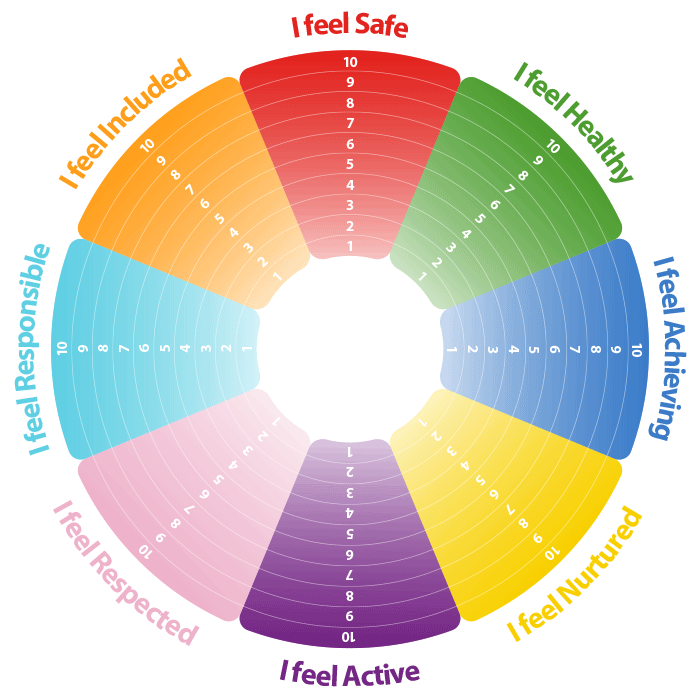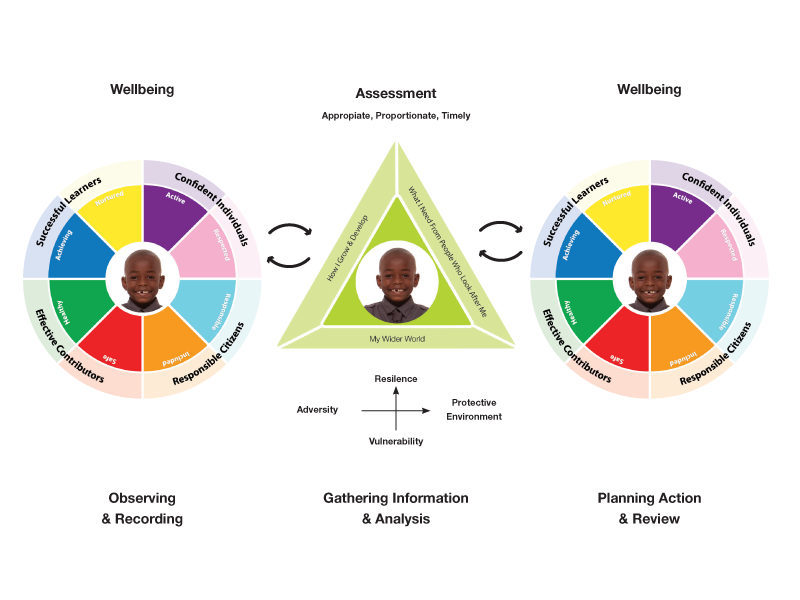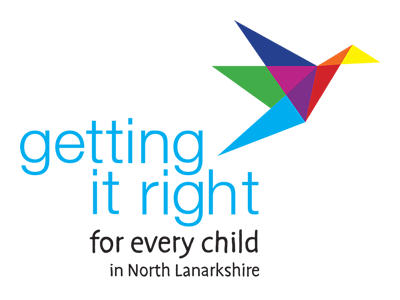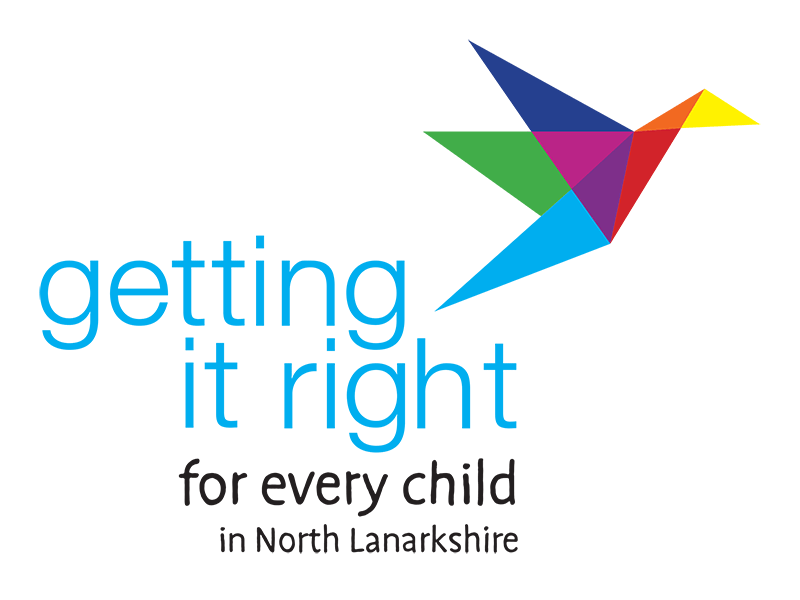Practitioners
What does GIRFEC mean for me?
Getting it right for every child (GIRFEC) is a national policy driver which seeks to make Scotland the best place for children and young people to grow up in.
The main aim of GIRFEC is to improve outcomes for all children and young people.
It is recognised that parents or carers of children and young people are the best people to ensure their child’s wellbeing is the best it can be. What is meant by wellbeing is that children will be safe, healthy, achieving, nurtured, active, respected, responsible and included. Most parents and carers usually have family and friends around them to support them to do this.
There may be times however, when they need additional help to develop their child’s wellbeing. Health professionals (health visitors) and education staff (early years staff, and teachers) have a key role to support and nurture the wellbeing of all children and young people. You, as a professional, should be able to offer advice and support or signpost them to the right person who can help them.
The GIRFEC approach ensures every child or young person will have a designated Named Person available to them. This is an identified professional whose job it is to be a first point of contact for children, parents or anyone who has a concern about a child or young person’s wellbeing.
The child or young person’s Named Person will be available to provide information, support or advice, or can help them to access, or signpost them to appropriate services when needed.
To read more about GIRFEC follow this link to the Scottish Government GIRFEC website.
Planning Pathways
In North Lanarkshire agencies have come together under GIRFEC and have agreed on a single pathway for planning and support for school age children and young people. The pathway supports agencies to work together to assess, plan and assist children, young people and their families to develop their wellbeing.
The pathway enables agencies across education, health and social work to use the Core Components of GIRFEC to ensure the most timely and proportionate support is available to children, young people and their families. The Children and Young People’s Pathway for Planning and Support encompasses three levels of GIRFEC; Universal, Additional and Intensive Intervention which are reflected within a Model of Staged Intervention.
For pre-school children there is a universal health visiting pathway.
What is Wellbeing?
The United Nations Convention on the Rights of the Child (UNCRC) is fully embedded within the values and principles of the GIRFEC approach promoting the wellbeing of all children and young people.
The GIRFEC definition of wellbeing is drawn from eight key areas that contribute to children’s optimal development. These eight indicators of wellbeing, safe, healthy, achieving, nurtured, active, respected, responsible and included are often referred to as Shanarri.
It is the aspiration of North Lanarkshire Council that all children and young people will be safe, healthy, achieving, nurtured, active, respected, responsible and included so that they can grow to be successful learners, confident individuals, effective contributors and responsible citizens.
Some of the main tools you can use to help children and young people think about and understand their own wellbeing and the wellbeing of others are:
Wellbeing wheel
Children and young people are familiar with the indictors of wellbeing and staff are using the wellbeing wheel to support discussion about wellbeing in nursey and school.
Click on a Wellbeing indicator to find out more.
Wellbeing web
Staff support children and young people to use the wellbeing web to map out their own wellbeing which can be revisited over time to record any changes in the child’s wellbeing. (1 = not so good, 10 = brilliant)

What I think tool
Is used by children and young people to think about the people who support them with their wellbeing and any difficulties they might be experiencing. Usually an adult who knows the child well will support the child through the discussion and will record the answers with the child. There are three documents available, one for pre-school children, one for primary and secondary aged children and one for young people 16+.
Sid and Shanarri
Sid and Shanarri is a storybook and game resource designed for use with pre-school children. It is available for use in all our nursery provisions to help young children understand what is meant by wellbeing.
You can learn more at the website SidandShanarri.co.uk.
Roles and Responsibilities
While is everyone’s responsibility to ensure the wellbeing of all children and young people is the best it can be. There are times when children, young people and their families may need some help from others.
This section provides fuller information on key staff and processes which can support children, young people and their families when they need help.
Named Person
Within North Lanarkshire, every child has an identified Named Person. There is no obligation on children, young people and families to accept the offer of advice or support from a Named Person.
Local arrangements and the term used to describe this role may vary from area to area but in North Lanarkshire we continue to use the term Named Person.
From birth, colleagues from health (health visitor or family nurse) presume the role of Named Person and when a child enters primary school (including specialist provision) education assume responsibility for the role.
In most cases, the Named Person will be the depute or head teacher of a primary school (unless a principal teacher has been identified) and in secondary school, the Named Person will be a Principal Teacher usually from the Pupil Support department or a Depute Head Teacher.
Each Establishment should ensure that children and young people and their families, know who their Named Person is, how to contact them and how they can help. This should be reviewed and updated when key staff change.
At the start of each academic year information should be refreshed and updated to ensure new staff are aware of the role and to ensure staff changes are communicated to children and young people (and families). This will be particularly relevant during transition times from nursery to primary school and from primary to secondary.
The Named Person has a responsibility to help promote, safeguard and support a child or young person’s wellbeing. Wellbeing is defined within the eight indicators, safe, healthy, achieving, nurtured, active, respected, responsible and included.
The Named Person’s role is to help ensure a child or young person’s wellbeing is fully supported and developed, by
- being the main point of contact for children, young people and their families
- providing advice, information or support to the child, young person or parent or carer
- helping the child or young person access relevant and appropriate support or a service
- ensuring any support is proportionate and informed by the child or young person’s views
- to support assessment, planning and develop chronology for the child or young person as required.
Getting it right for every child – Practice Guidance 2 – Role of the named person – 2022
Assessment
The Girfec National Practice model provides a framework for practitioners in all services to gather, structure and analyse information in a consistent way. The framework helps staff to identify and understand the strengths and pressures for children and their parents, the child or young person’s needs and any risks. The model promotes the participation of children, young people and families as central to assessment and planning.
GIRFEC National Practice Model

Getting it right for every child – Practice Guidance 1 – Using the National Practice Model – 2022
Most children and young people progress through nursery and school without the need of any additional support. A small number however, will from time to time require assistance to support their wellbeing. All staff working with children use the wellbeing indicators as a framework to assess the wellbeing of all children and young people.
Tools used by all staff for assessment are based on wellbeing.
These tools allow staff to assess children’s strengths and difficulties against the eight indicators of wellbeing. By including assessment of a child’s strengths, staff can build on the child’s strengths to help improve any areas of need.
The My World assessment triangle considers the whole child in context –‘My wider world’, ‘How I grow and develop’ and ‘What I need from people who look after me’
Robust assessment along with the five practitioner questions allows staff to identify what might be needed to enable planning for the child to begin.
Five key practitioner questions
- What is getting in the way of the child or young person’s wellbeing?
- Do I have all the information I need to help this child or young person
- What can I do now to help this child or young person?
- What can my agency do to help this child or young person?
- What additional help, if any, may be needed?
Planning
In nurseries and schools staff begin individual planning for children as soon as needs are identified that require an action by staff.
Getting it right for me plan
The Getting it right for me plan (GIRFMe plan) allows staff to record strategies, resources, interventions from the earliest point to prevent difficulties escalating. If a child needs specific learning objectives to support their wellbeing, these are recorded in their GIRFMe plan also. Children and parents will always be involved in planning and will be asked for their comments and ideas to support the plan.
Health visitors may use health’s Wellbeing plan when actions are required to improve the wellbeing of a young child, not yet attending school.
Child’s Plan
The Named Person may need to bring in additional help or support to enable planning to be effective for a child. Where more intensive support for a child needs to be planned for, usually when a number of agencies are involved in supporting the child’s wellbeing, then a Child’s Plan may be developed. The plan states what actions need to be taken and by whom.
When a Child’s plan is developed it will be managed by a ‘Lead Professional’ who will have the job of making sure that the actions outlined in the plan take place and things improve for the child. Children and parents will always be involved in the planning process, their views sought and ideas shared.
Participation and Engagement
The refreshed GIRFEC national practice model places greater emphasis on child-centred, strengths-based practice and the inclusion of children , young people and their families at every stage of the process. It enables full participation of children, young people and their families in gathering information to assess what support they may need and to make joint decisions to plan and deliver that support.
In the GIRFEC approach, any child or young person who requires additional support should have a plan to address their needs and improve their wellbeing. Every plan, whether it is single or multiagency, should include and record the views of the child or young person and their family.
There are a range of tools available for practitioners to use to gather the views of children and young people including: wellbeing wheel; what I think; mind of my own; and outcomes star.
Babies and young children have a right to meaningful participation. The voice of the infant best practice guidelines have been developed to support practitioners to notice, facilitate and share infant’s feelings and preferences.
www.gov.scot/publications/voice-infant-best-practice-guidelines-infant-pledge/
Coordinated Support Plan
Additional Support for Learning (Scotland) Act 2004, 2009 states that where coordination of support (provided by at least one agency other than education) for a child or young person is required to enable them to access learning, and that support is likely to last for a year or more, then a Coordinated Support Plan (CSP) should be considered for the child and put in place if the criteria is met.
The CSP is a legal document and guidance on its use can be found in Policy into Practice 2, appendix 2 (Management Circular C4)
Health Care Plan
For children and young people with complex health care needs, colleagues in health provide a Health Care Plan for education staff when the child or young person is in nursery or school. The Health Care Plan can only be written by health staff.
Chronology
Chronology is a tool that practitioners from a range of disciplines can use to help them understand what is happening in the life of a child. Simplistically it is a list, in date order, of all the major changes and significant events in a child’s life. It provides a brief and summarised account of events and provides an immediate overview.
Chronology can be a useful part of the assessment process. Health colleagues keep a chronology on every child, education staff will only have a chronology for a child when there is a need to start one and social work will have a chronology for every child or young person they work with and support.
Lead Professional
In some circumstances there may be two or more agencies working together to improve outcomes for a child or young person. The team around the child will consider the level of planning for the child and if a Child’s Plan is deemed appropriate a Lead Professional will be identified to manage the Child’s Plan.
The Lead Professional will:
- make sure the child and their family understand what is happening so that they can all be involved in all the decisions that affect the child
- will co-ordinate the plan and check whether all the things that people said they would do are being done
- ensure the information in the Child’s Plan is accurate and up-to-date and is being shared with the child and all the people involved in the Child’s Plan
- ensure that the plan is regularly reviewed to make sure it is continuing to support the child’s needs.
When a child is on the Child Protection register or is on a Care Order the Lead Professional will always be the child’s social worker.
Getting it right for every child – Practice Guidance 3 – Role of the lead professional – 2022
Sharing information
GIRFEC is about making sure children, young people and their families get the help they need, when they need it. So when staff from different agencies are working together to support planning for a child or young person, they may need to share information.
Staff should be mindful of the United Nations Convention on Human Rights (UNCHR) and the Data Protection Act when considering what information to share. Information should always be proportionate, up to date and relate directly to the wellbeing needs of the child or young person when seeking support, advice or resources.
The laws which set out the rules for how information (data) is shared are changing. The European Union has new legislation called the General Data Protection Regulations GDPR (EU) which comes into force on the 25th May 2018. The British Government is updating the British Data Protection Act to support the implementation of GDPR.
We will tell you about any changes to practice following implementation of the new pieces of legislation.
Staff should usually inform parents, carers and in some cases children and young people that they intend to share information about the child or the family, so that outcomes for the child or young person can be improved.
Staff will not inform a parent or carer if there is a risk to the child or young person (i.e. that discussing with the parent or carer what is being shared may put the child or young person at greater risk) usually in child protection cases.
Staff should explain to parents, carers, children and young people what information is to be shared, with whom and why the information is being shared and what hopes to be achieved by sharing the information?
To support practitioners when sharing information please refer to the GIRFEC Practice Guidance 4 Information Sharing 2022. Further guidance on operational procedures is available from the North Children’s Service Information Sharing Agreement.
Getting it right for every child – Practice Guidance 4 – Information Sharing – 2022


